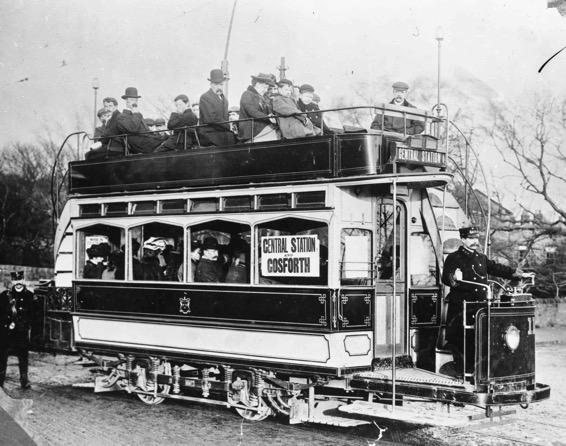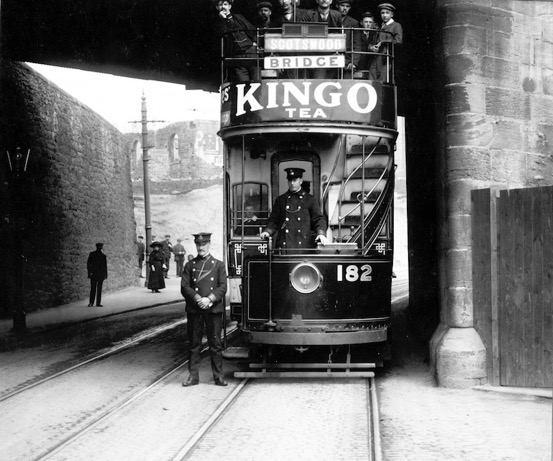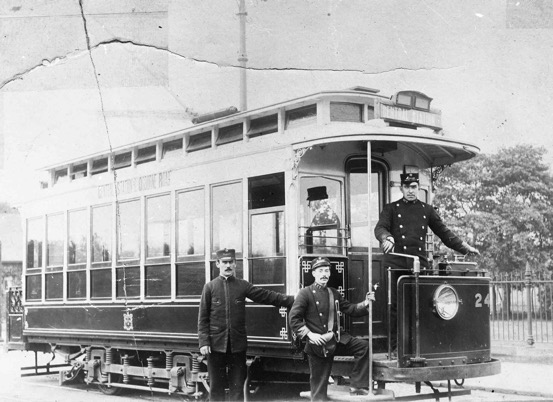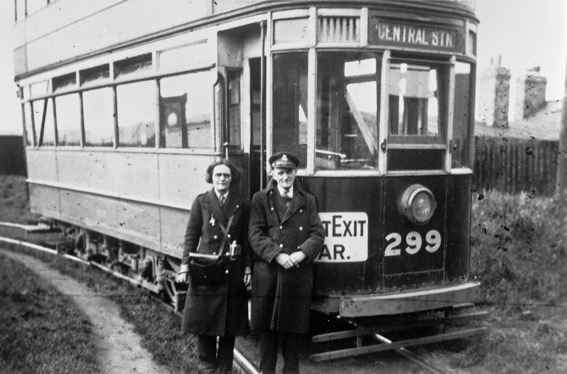Newcastle Corporation Tramways
History
Newcastle became a tramway owner on the 5th December 1878, when services commenced on its newly-built, standard-gauge horse tramway; the corporation did, however, not operate the tramway itself — this was prohibited by the Tramways Act of 1870 — so it was leased to William Turton and Daniel Busby. Turton and Busby were well-known tramway entrepreneurs, who either separately or together had interests in several horse tramways in the north of England, most notably, those of Manchester, Leeds, Liverpool and Salford.
In 1892, the corporation started a long and ultimately fruitless dalliance with the idea of converting some or all its lines to cable traction. Electric traction was also coming to the fore, and whilst the corporation took a long, hard look at its options, key voices in the council were set against the perceived disfigurement of overhead electric wires, and in November 1895, the full council voted to promote a cable system. There followed, however, a further and protracted period of discussion, including not just the question of traction — cable, conduit and overhead all being in contention — but whether the corporation wished to lease whatever new system it built, or whether it would operate it itself. On the 25th January 1898, the council finally decided to obtain powers to run the tramway itself following the end of the company's lease (11th November 1899), and these were duly acquired during 1899.
Relations between the corporation and the lessee — by this time the Newcastle and Gosforth Tramway and Carriage Company — were, however, not exactly cordial, given that the latter had been hoping to lease the new tramway, and had to some extent been strung along by the council's inability to make up its mind. Nevertheless, on the 7th November 1899, agreement was reached for the company to continue working the horse tramway until the corporation was ready to convert the existing lines to overhead electric traction (a decision having finally been made on the form of traction to be used), initially to the 1st December 1899, and thereafter, subject to three months' notice.
Construction of the new system commenced on the 19th April 1900, and on the 10th January 1901, the council gave notice to the company that the lease of the existing lines would be terminated on the 13th April 1901. The corporation seemingly wanted the company to continue working the lines during conversion, but the company was not interested in the terms offered, so all services stopped that day, leaving omnibuses to fill the transport gap for the best part of eight months.
By the end of December 1901, 14.75 miles of track were in operation, with two extensions opening in 1906 and 1907, six between 1912 and 1916, and ten in the 1920s, the last of all being in 1928 over the new Tyne Bridge. The last major addition to the system came in 1930 when the NCT acquired the Tyneside Tramways and Tramroads Company's Gosforth to Gosforth Park Gates, and Neptune Bank to Wallsend lines following the closure of that company's tramway system on the 6th April 1930. The department had wanted to acquire the entire tramway system, but was prevented from doing so by the council, who baulked at the expense involved.
At its greatest extent, Newcastle Corporation operated 51.27 miles of tramway, including tracks within the neighbouring municipalities of Gosforth, Longbenton, Newburn, Wallsend and Westerhope. The system comprised lines running: westwards through Scotswood to Throckley, through Elswick to Benton, and along Westmoreland Road to Gluehouse Lane; northwestwards along Westgate Road to the Fox and Hounds, with a branch leading off along Elswick Road to Benwell, and along Fenham Hall Drive to Westerhope, with a branch along Silver Lonnen to Denton Burn; northwards along the Great North Road to Gosforth Park Gates, turning east to West Moor; northeastwards along Jesmond Road to Benton Road, with branches to Jesmond and Jesmond Dene Road; northwards along Chillingham Road and Benton Road to West Moor, with a branch along Whitley Road to Forest Hall; eastwards to Wallsend via Shields Road and Welbeck Road, and along the Tyne via Walker Road to Neptune Bank. The tramway met the tracks of the TT&TCo at Gosforth, Shields Road and Neptune Bank, with NCT cars eventually running through to Gosforth Park and Wallsend, and TT&TCo cars running into Newcastle Stanhope Street. In the 1920s, the NCT tracks were also connected to those of the Gateshead and District Tramways Company — via the High Level Bridge (in 1923) and the newly built Tyne Bridge (in 1928) — with NCT cars running through to various destinations in Gateshead, and G&DTCo cars running through similarly to various destinations in Newcastle.
The name of the enterprise was officially changed to Newcastle Corporation Transport and Electricity Undertaking in 1915, though the use of 'Transport' rather than 'Tramways' on vehicles, uniforms and paperwork does not appear to have become widespread until the 1940s.
Like most systems nationally, the NCT was placed under immense pressure during the Great War, with significantly increased loadings, greatly reduced maintenance and severe restrictions on the purchase of new rails, tramcars and spares; additionally, severe staff shortages necessitated the employment of conductresses and part-time motormen. As such, the system emerged from the conflict in run-down condition, and into a post-war world of high inflation, and ultimately, economic depression. Despite these challenges, the corporation continued to invest in its tramway, with significant expansion of the system during the 1920s, including renewal of track and modernisation of the tramcar fleet. The NCT first introduced bus services — as feeders to the tramway lines — as early as 1912, but still only had fives routes as late as 1925, some having been replaced by tramway extensions.
Whilst the corporation still viewed the tramways as the backbone of municipal transport during the 1920s, by the end of the decade, the position was subtly changing, with the trams increasingly being viewed as the past, and buses/trolleybuses as the future. Although tramway abandonment was in no way a policy goal, it was clear that as routes came up for major expenditure (primarily track renewal) other options would be explored. Although minor and poorly used sections of track had been abandoned over the years, the first significant tramway abandonments came on the last day of September 1935 (east/west services using Westgate Road and City Road), with trolleybuses taking over the following day. Thereafter, tramway closures came throughout the decade, some being replaced by trolleybuses and others by buses, though final abandonment was inevitably postponed by the outbreak of the Second World War. Further closures came towards the end of the war, though it was to be a new decade before the final NCT tram bowed out, on the 4th March 1950. This was not, however, the last tram to run in the city, that honour going to the G&DTCo, whose final service between Newcastle and Gateshead ran on the 4th August 1951.
Uniforms
On commencement of corporation-operated electric services (in December 1901), motormen and conductors were issued with double-breasted, lancer-style tunics with five pairs of buttons (narrowing from top to bottom, and bearing the full corporation title and device — see link), two waist-level pockets, and stand-up collars; the latter bore an employee number on the bearer's left-hand side (in individual metal numerals), and system initials — 'N C T' — on the right-hand side (in individual metal letters). The tunic had a pronounced seam down the centre, an uncommon design, though not unique to Newcastle. Caps were initially in a drooping-peak style and carried a script-lettering grade badge — either 'Motorman' or 'Conductor' — above which a small municipal-device badge was worn. The drooping-peak caps were relatively quickly superseded — probably around 1905/6 — by peaked caps with tensioned crowns (tops); these continued to bear the municipal-device badge, but instead of the previous script-lettering grade badge, an employee number was now carried; motormen had even numbers and conductors odd. All insignia were presumably brass to start with (brass buttons have survived), a material which was at some point superseded by nickel, possibly at the same time the drooping-peak caps were dispensed with.
Staff were also issued with long, double-breasted greatcoats with five pairs of buttons, and high fold-over collars; an employee number was worn on the left-hand collar and individual 'N C T' system initials on the right-hand side.
The uniforms were piped in red until around 1926, when a change was made to blue. During the 1940s, the old lancer-style tunics were superseded by more modern single-breasted jackets with lapels, though these are seldom seen on surviving images, as most crews appear to have been captured photographically in their greatcoats. In the last years of operation, the caps were changed to a more modern soft-topped style with a glossy peak; they continued to carry the same insignia as previously. It seems likely that a switch was made to uniforms bearing 'Newcastle Corporation Transport' insignia and buttons, possibly when the old lancer-style tunics were replaced in the 1940s.
Whilst relatively few photos of inspectors have survived from the first two decades of operation, what has indicates that they were issued with single-breasted jackets with hidden buttons (or more likely an hook and eye affair) with two slit breast pockets, two slit waist-level pockets, and stand-up collars; both the jacket and the pockets were edged in a finer material than the main body. The stand-up collars bore system initials — 'N C T' — on both sides in embroidered script lettering. Headgear was initially of the drooping-peak type, though by 1910, this type had given way to peaked caps with a tensioned crown. Both types bore a brocade hat band, above which the standard municipal-device badge was mounted. Whilst the hat bands on the drooping-peak caps bore a grade badge — 'Inspector' — which was probably brass, these appear to have been dispensed with by 1910.
A single photograph has survived of an inspector that was possibly taken just prior to the Great War. This image suggests that by this time, a switch had been made to single-breasted jackets with buttons rather than hook and eye fasteners. These new jackets retained stand-up collars, but also had epaulettes; whilst the latter were left plain (other than a button closure), the former continued to carry the same insignia as the earlier jackets.
At some point, inspectors' uniforms were changed to a single-breasted design with four buttons, two hip-level pockets (with flaps), two breast pockets (with scalloped flaps and button closures) and lapels; the collars bore system initials — 'N C T' — on both sides in embroidered script lettering. The grade cap badges were also reintroduced at some point, the brocade hat bands being bordered (above and below) with light-coloured piping. The style of jacket was also changed slightly in the last decade of operation through the addition of epaulettes.
In common with many other UK tramway systems, women were employed in significant numbers during the Great War to replace male staff lost to the armed services. Female staff were issued with long skirts and tailored, single-breasted jackets with five buttons, a waist belt (with two buttons), hip and breast pockets (with button closures), and high fold-over collars. An employee number was worn on the bearer's left-hand collar, with the right side left plain, i.e., without system initials. Two types of uniform are known, which although identical in style, were made from different materials, one probably serge and the other in a lighter cotton-like material; these two styles probably reflect winter and summer issues, respectively. Caps also appeared in two distinct styles, the heavier one being a baggy cap with a glossy peak, sometimes called a motor cap, and the other a wide-crown peaked cap; both carried the usual municipal-device badge and an employee number, though photos have also survived where the latter is absent. Conductresses were also provided with two styles of single-breasted topcoat, a heavy serge version, presumably for winter wear, and a lighter weight version, presumably for summer wear.
Female staff were also employed during the Second World War, though photographic evidence has so far been difficult to find.
Further reading
For a history of the system, see: 'The Tramways of Northumberland' by George S Hearse; self-published (1961).
Images
Motormen and conductors
A 111-130 series (Class A) tramcar at Little Bridge, Gosforth — photo taken in December 1901. Photo courtesy of the National Tramway Museum.
An enlargement of the above photograph showing the motorman, in double-breasted greatcoat and drooping-peak cap; the latter bears a script-lettering grade badge — 'Motorman' — above which is a small badge, almost certainly of the municipal-device pattern shown below.
Standard script-lettering cap badges of the type used by Newcastle Corporation Tramways in the early Edwardian era — brass. Author's Collection.
Newcastle municipal-device badge — nickel. These were worn on tramway staff caps throughout the tramway's life (1901 to 1950); they were probably brass until around 1904 and nickel thereafter. Author's Collection.
Tramcar No 34 and crew pictured at Jesmond — photo undated, but probably taken in 1902/3 judging by the relatively good condition of the vehicle. Photo courtesy of the West Newcastle Picture History Collection.
An enlargement of the above photograph showing the conductor and the motorman. Both men are wearing lancer-style tunics with stand-up collars, upon which are their employee numbers and system initials ('N C T'). The drooping-peak caps bear a municipal-device badge, along with a script-lettering grade badge.
An unidentified tramcar in the 131-165 series (Class D) at Heaton Road — photo undated, but judging by the immaculate condition of the vehicle, probably taken in 1905 when it was delivered. Author's Collection.
An enlargement of the above photograph showing the conductor and the motorman, both still wearing the early drooping-peak caps.
Tramcar No 182 (Class G) with crew, posed for the photographer at the Bridge, with a service for Scotswood — photo undated, but probably taken in 1906/7. Image kindly supplied by Beamish Museum Limited (see link), image copyright Beamish Museum Limited.
An enlargement of the above photograph showing the conductor (Employee No 401) and the motorman, the former in a lancer-style tunic and the latter in a double-breasted greatcoat. By this time, the caps had been changed to a tensioned-crown (top) type, which bore the usual municipal-device badge, but now with an employee number rather than a script-lettering grade badge.
A studio portrait of an unidentified Newcastle Corporation Tramways conductor — photo undated, but probably mid-to-late Edwardian. Author's Collection.
An enlargement of the above photograph revealing details of the jacket insignia ('N C T' on the bearer's right-hand collar and an employee number on the left-hand collar) and cap badges (municipal-device badge above an employee number). The employee number is odd (No 353), revealing the subject to have been a conductor.
A Newcastle motorman — photo undated, but probably taken in the late-Edwardian era. Image kindly supplied by Beamish Museum Limited (see link), image copyright Beamish Museum Limited.
Class G tramcar No 191 and its crew, captured for posterity under the railway bridge on Scotswood Road — photo undated, but probably late Edwardian. Author's Collection. 
An enlargement of the above photograph showing the motorman (Employee No 340) and his conductor. 
A group of motormen and conductors pose on a tramcar platform — photo undated, but almost certainly taken during or shortly after the Great War, given that two of the individuals are wearing medal ribbons, whilst the gentleman at the centre, back, has a regimental badge on the side of his cap. The employee numerals — on both the caps and the left-hand collars — are clearly seen, as is the municipal-device cap badge and the pronounced seam down the centre of the tunics. With thanks to Malcolm Fraser.
A group of motormen and conductors pose for the photographer at Byker Depot in the early 1920s. With thanks to Malcolm Fraser.
Two conductors and a motorman pose in an unidentified depot with what is probably Tramcar No 93 (Class F); this was damaged in an accident and is thought to have been vestibuled in the late 1930s, so this is the earliest date that the photo could have been taken. With thanks to Malcolm Fraser for this information. Author's Collection.
An enlargement of the above photograph revealing the two conductors to be Employees Nos 303 and 291.
Senior staff
An inspector, a conductor and a motorman pose with an immaculate No 24 at what is possibly Jesmond — photo undated, but probably taken in 1902/3 given that the vehicle side panels and windows, which were originally open, have been enclosed. Photo courtesy of the National Tramway Museum.
An enlargement of the above photograph showing the inspector. He is wearing a fairly typical tramway inspector's jacket, along with a drooping-peak cap bearing the standard municipal-device badge, and what would appear to be a metal grade badge, 'Inspector'.
An enlargement of the 1905 Class D tramcar photograph above showing the inspector.
A 1910 photograph of Newcastle Corporation Tramways Band, which includes two senior uniformed staff, most probably inspectors (centre, seated; extreme right, standing). Photo courtesy of Gavin Holman.
An enlargement of the above photograph showing the inspector seated in the centre. He is wearing a jacket with hook and eye fastenings, the collars of which bear 'N C T' in embroidered script lettering. The older style of drooping-peak cap had by this time evidently been replaced by a tensioned-crowned type; it bears a brocade hat band with the standard municipal-device badge, but without a grade badge.
Another enlargement of the above photograph showing the inspector on the right. He is wearing the identical uniform and cap to the man in the previous image, once again without any grade insignia.
An inspector and a group of tramcar staff pose with what is believed to be Tramcar No 135 — photo undated, but possibly taken just before the Great War. Photo courtesy of the National Tramway Museum.
An enlargement of the above photograph showing the inspector. He is wearing a single-breasted button jacket with epaulettes and stand-up collars, along with a tensioned-crown peaked cap without a grade.
Inspector Brown of Newcastle Corporation Tramways pictured in 1937. His jacket collars bear embroidered system initials — 'N C T' — whilst his cap carries the standard municipal-device badge, along with his grade (on a brocade hat band). Photo courtesy of the West Newcastle Picture History Collection.
Another shot of Inspector Brown, but taken in 1946; by this time, the jackets issued to inspectors had clearly acquired epaulettes. The script-lettering grade badge — 'Inspector' — appears to be metal rather than embroidered, and was probably nickel. West Newcastle Picture History Collection.
'Inspector' script-lettering cap badge, of the type used by Newcastle Corporation Tramways towards the end of the system's life — nickel. Author's Collection.
A Newcastle Corporation employee. There is no evidence whatsoever to suggest that the subject worked in the Tramways Department, though it remains a possibility. Author's Collection.
Female staff
A group of conductresses and their male colleagues pose for the camera at Wingrove Depot, Fenham in 1915. Many of the ladies are wearing their tunics unbuttoned at the top, giving a false impression of lapels. The lady on the back row, far right, is Josephina Robinson (see studio portrait below). With thanks to Malcolm Fraser.
Great War NCT tram conductress Josephina Robinson (née Jackson), who was born on the 24th August 1888 in Cockermouth, which means that she would have been in her late twenties when the photo was taken. Her husband — George Robinson — fought in the Great War, so relatives presumably looked after the couple's three children whilst Josephina was conducting. She lived in Adair Avenue, not far from Wingrove Depot, and died there on the 13th August 1973, just short of her 85th birthday. Photo and information courtesy of Josephina's great granddaughter, Lisa Robinson.
Newcastle Corporation Tramways Great War conductress Hilda Rogan. Miss Rogan was Employee No 311, the number appearing on her left tunic collar and on her cap. Photo courtesy of the Stephen Howarth Collection.
An NCT Great War tram conductress (Employee No 207) poses for an unusual outside shot. Although the jacket and skirt are the same style as seen in other photographs, the material appears to be much lighter than in other shots (possibly cotton, rather than serge), suggesting that it may have been for summer use. The subject's cap is of the wide-crown peaked type rather than the usual baggy motor cap. The photograph was taken by J W Middleton of Newcastle, a company which presumably took these photos with the aim of selling at least one or two of them to the subject. On the back of the postcard, the subject — Josie — states: "There are not many men conductors left". Author's Collection.
Conductress Mary Wheatley Sutherland (Employee No 613) and her motorman (Employee No 524), aboard the platform of Tramcar No 138 — photo undated, but undoubtedly taken during or shortly after the Great War. Mary Sutherland was born in 1901, so was probably only 18 years old when the photo was taken. Photograph courtesy of her grand-daughter, Judith Sutherland.
A Great War photograph of what are, in all likelihood, three tramcar crews, Whilst the image is unfortunately out of focus, it does show two conductresses, one in a winter topcoat, and one in a lighter weight summer topcoat. Author's Collection.
An unidentified NCT conductress and her motorman pose in front of Tramcar No 299 (Class B) at the Scotswood Bridge turning circle — photo dated 1949. Image kindly supplied by Beamish Museum Limited (see link), image copyright Beamish Museum Limited.
An enlargement of the above photograph showing the tramcar crew. The motorman appears to be wearing an open-necked modern jacket under his great coat, and in contrast to the earlier tensioned crown caps, this one is soft topped.